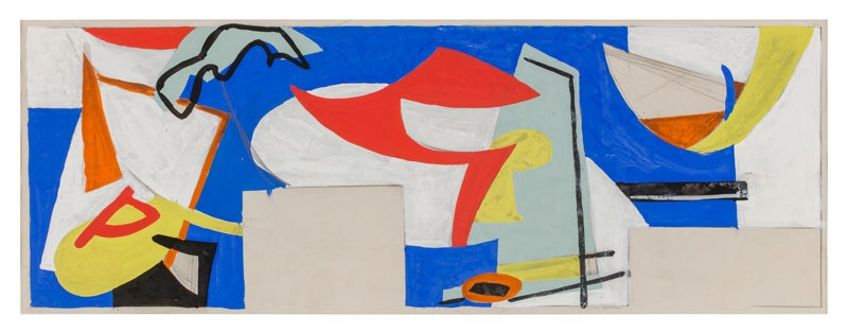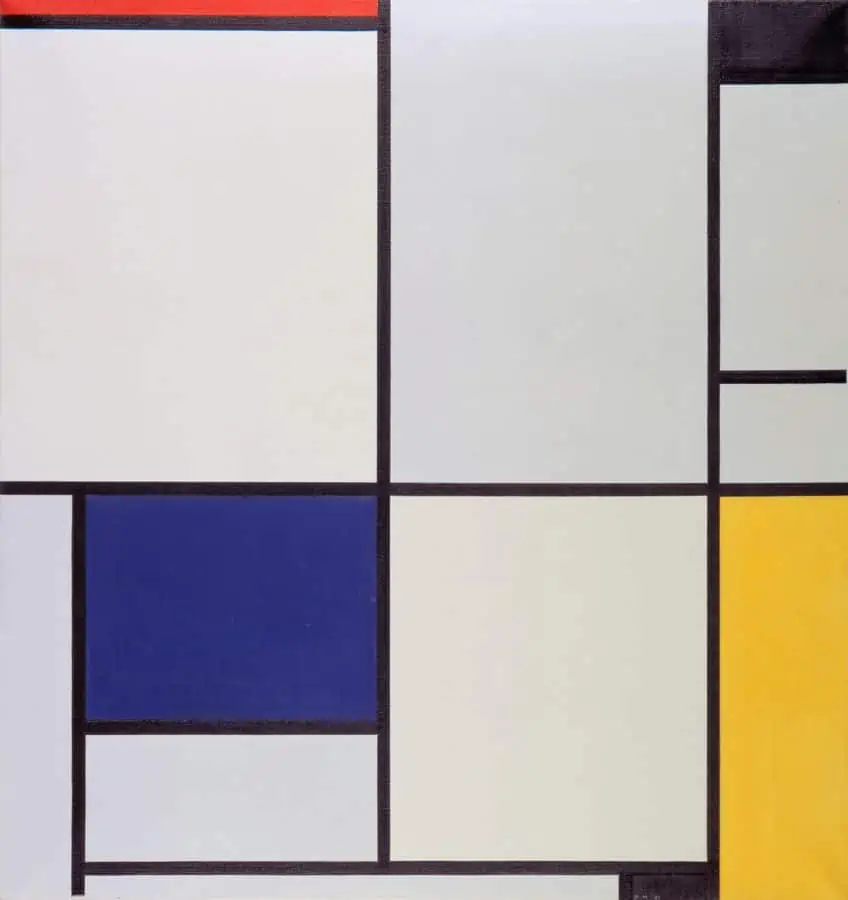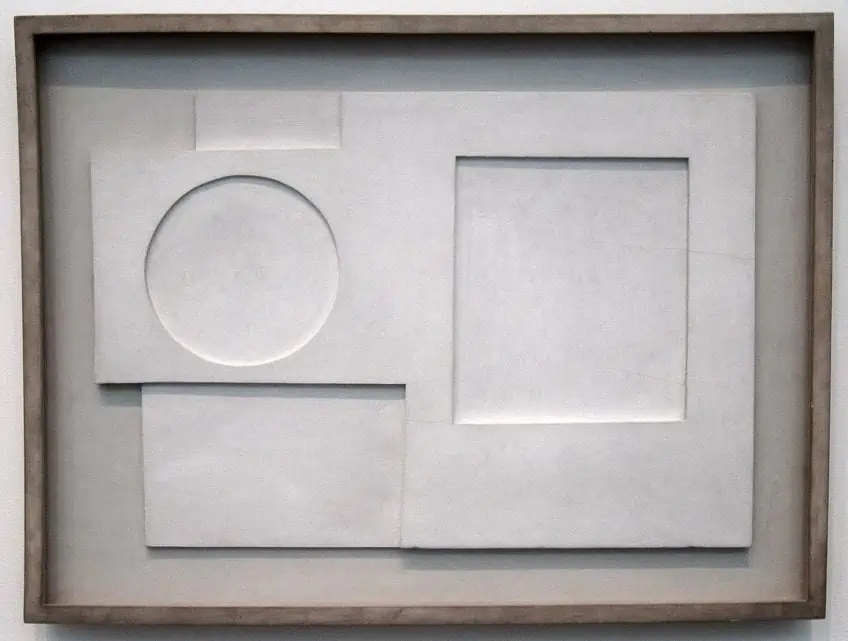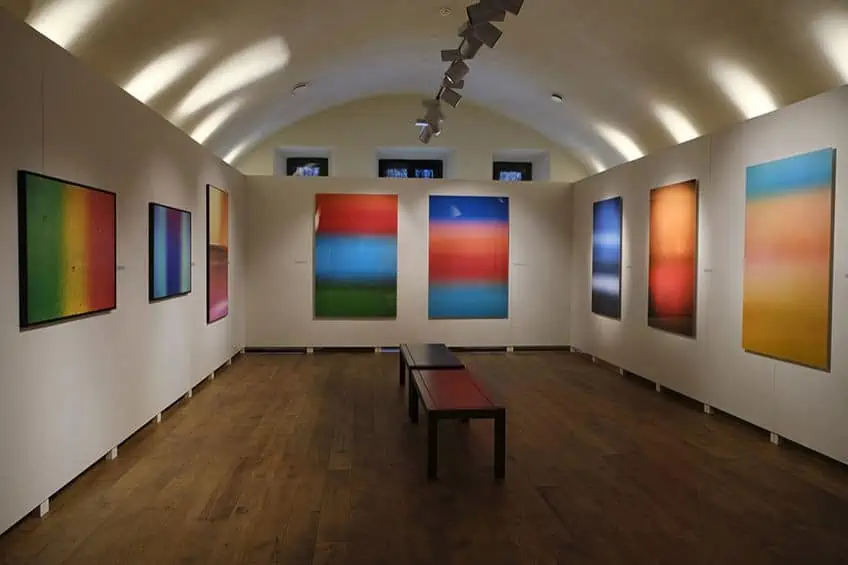Famous Abstract Art – Explore the Best 11 Works of Art
Abstract art paintings broke the mold of the staid late-19th-century art style that was prominent at the time. The need for an art movement that broke the rules of convention and searched for new methods of communication arose, and many famous Abstract paintings were produced to answer that call. In our search for the best Abstract paintings, we will explore several famous Abstract art examples that were renowned for helping establish and expand this innovative movement’s techniques and styles.
The Most Famous Abstract Artworks
While much of art history had focused on accurate representation of the world around us, artists in the 20th century began to search for techniques and styles that allowed them the freedom to express themselves without restraint, instead portraying the images they experienced in their imaginations. The world around them was changing in terms of philosophy, technology, and scientific advancement, and Abstract artists wanted to embrace this change and move away from traditional art forms, establishing Modern art.

Abstract art examples range from products of the imagination to forms that look familiar to those which we observe in the world around us, yet are highly abstracted to the point of not being obviously identified as anything specific. As there is less emphasis on objects and individuals in Abstract art paintings, the viewer is more likely to engage with them on a purely emotional level or to find something that speaks to them personally. Famous Abstract artworks allow the individual to experience the artwork subjectively, and to find something of themselves inside of its gestural lines, shapes, colors, and forms.
Untitled (First Abstract Watercolor) (1910) by Wassily Kandinsky
| Artist | Wassily Kandinsky (1866 – 1944) |
| Date Completed | 1910 |
| Medium | Watercolor and ink |
| Dimensions (cm) | 49 x 64 |
| Location | Musée National d’Art Moderne, Paris, France |
Russian-born artist and theorist, Wassily Kandinsky, is regarded by many as a forefather of abstract painting. He started his career as a lawyer, but then made a life-changing decision to pursue art instead and traveled to Munich in 1896. His early works were influenced by the Impressionist and Post-Impressionist schools, but he eventually shifted away from representational imagery and toward abstraction. He felt that art should reflect the emotional and spiritual aspects that humans experience rather than simply representing the physical world around them.
Kandinsky’s style developed over time, but his paintings are typically distinguished by their vivid application of color, abstracted forms, and dynamic compositions.
Produced in 1910, this is regarded as a significant work in the emergence of abstract painting and is regarded as Kandinsky’s first totally abstract piece of art. It’s made up of overlapping and interconnecting lines, shapes, and colors. The painting’s forms convey geometric and organic shapes, although they are not representational of anything observed in reality. Instead, they are intended to represent the artist’s spiritual and emotional reaction to the world around him. Although the painting is flat, the forms in it appear to pulsate and vibrate, and they are structured in a way that evokes dimension and space. This famous abstract artwork is noteworthy because it marks a pivotal moment in Kandinsky’s career when he started moving away from representational painting and toward abstraction.

Tableau I (1921) by Piet Mondrian
| Artist | Piet Mondrian (1872 – 1944) |
| Date Completed | 1921 |
| Medium | Oil on canvas |
| Dimensions (cm) | 96 x 60 |
| Location | Museum Ludwig, Cologne, Germany |
Dutch artist Piet Mondrian was also regarded as influential in the growth of abstract artwork, especially geometric abstraction. He was a founding member of the De Stijl movement, which aimed to establish a global visual language based on simplified colors and forms. His early artwork was inspired by the natural world, yet in the early 1900s, he started experimenting with abstraction, ultimately creating a style known as Neoplasticism. This style was distinguished by a grid of black lines that served as a framework for sections of primary colors, often yellow, red, and blue, as well as non-colors, namely white, black, and gray.
This specific piece was produced during his neoplasticism phase. It exemplifies Mondrian’s use of reduced forms, colors, and lines to establish harmony and equilibrium in his works.
It is made up of a grid of black lines that divides the canvas into squares and rectangles. Several of these shapes are painted with primary colors like blue, red, and yellow, while others are filled with white, black, and gray. Mondrian felt that using primary colors and basic geometric shapes could convey the world’s fundamental universal truths. Mondrian’s application of the grid as a compositional tool had a long-lasting influence on graphic design as well as other kinds of visual communication.

La Manch Roja (1925) by Joan Miró
| Artist | Joan Miró (1893 – 1983) |
| Date Completed | 1925 |
| Medium | Oil and pastel on canvas |
| Dimensions (cm) | 146 x 114 |
| Location | Solomon R. Guggenheim Museum, New York City, United States |
Over his career, Joan Miró was associated with several diverse art groups, such as Dadaism and Surrealism, but his artwork is arguably most noted for its use of striking, abstracted forms and vivid colors. His early paintings were influenced by Catalan landscape art and traditional Spanish paintings, however, in the 1920s, he started experimenting with abstraction, subsequently developing a style distinguished by bold colors, biomorphic forms, and a spirit of spontaneity. Miró felt that art should reflect the subconscious parts of the human mind and the irrational realms within, and his works often included the concepts of automatism and chance.
His artistic influence can be observed in the works of other famous abstract artists, such as Jackson Pollock and Mark Rothko, who were interested in the expressive power of form and color like Miró.
This famous Abstract artwork is a playful but equally disturbing art piece that exists somewhere in the space between Surrealism and Abstraction. Mondrian, who never really considered himself an abstract artist, stated that at the end of a rather grueling day, he sat down and depicted the imagery that was within his subconscious mind. This artwork, based on his subconscious thoughts, helped open the way for artists’ visions and dreams to permeate the canvas. It is one of several Miró pieces in the Solomon R. Guggenheim Museum’s collection and is generally considered to be an important representation of his early abstract style.
1936 White Relief (1936) by Ben Nicholson
| Artist | Ben Nicholson (1894 – 1982) |
| Date Completed | 1936 |
| Medium | Oil on carved board |
| Dimensions (cm) | 106 x 135 |
| Location | Tate Museum, London, United Kingdom |
Nicholson was among the first British painters to adopt abstract art’s ideals, and he was a key figure in the formation of what became known as the “St. Ives School” of artists in the county of Cornwall in England. Nicholson was influenced by the works of painters like Georges Braque and Pablo Picasso, and he wanted to establish an abstract style based on balance and geometry. Nicholson’s works shaped the growth of abstract art in the United Kingdom and abroad.
He was instrumental in popularizing abstract painting concepts and in establishing a new visual language that valued balance, simplicity, and order.
This artwork is part of his White Relief series, which is distinguished by its white color scheme and geometric forms. The piece is composed of a sequence of white-painted wooden parts arranged to form a relief sculpture. Rectangles, squares, and circles are among the shapes used, and they are positioned in a way that results in a beautifully balanced composition. The work’s surface is smooth and consistent, with no discernible brushstrokes or textures. His art was influenced by the ideals of the Dutch De Stijl movement, which prioritized geometric shapes and primary colors. The White Relief series, specifically, was influenced by the work of Kazimir Malevich, a Russian artist who explored pure abstraction.

Full Fathom Five (1947) by Jackson Pollock
| Artist | Jackson Pollock (1912 – 1956) |
| Date Completed | 1947 |
| Medium | Oil paint and key, coins, buttons, and cigarette butts on canvas |
| Dimensions (cm) | 129 x 76 |
| Location | The Museum of Modern Art, New York City, United States |
Jackson Pollock was born in Wyoming and lived in both Arizona and California before attending art school and working in New York, where he commanded the art scene, being generally widely acknowledged as America’s foremost Abstract Expressionist. Pollock’s painting style was part of the greater abstract expressionist movement that arose in the United States throughout the 1940s and 1950s. This movement promoted the free and painterly application of paint on canvas, which produced highly expressive and emotive art pieces.
Pollock was a brilliant and prolific draftsman in addition to being most renowned for the drip paintings that have come to embody the creativity and freedoms of Abstract Expressionism.
This is an early “drip” painting by Pollock. He created the underlayer with a brush and palette knife, while the lacelike upper levels are made out of poured skeins of home paint. A closer examination reveals nails, cigarette butts, thumbtacks, coins, buttons, and a key buried in the surface. Despite the fact that many of these objects are covered by paint, they all contribute to the artwork’s layered and textured aesthetic. The title of this famous Abstract artwork refers to a phrase from Shakespeare’s play The Tempest that recounts a shipwrecked sailor’s body resting at the bottom of the ocean. The mix of texture, color, and movement in this artwork makes it a striking example of the abstract expressionist style, and it still continues to influence artists to the present day.
Mountains and Sea (1952) by Helen Frankenthaler
| Artist | Helen Frankenthaler (1928 – 2011) |
| Date Completed | 1952 |
| Medium | Oil and charcoal on canvas |
| Dimensions (cm) | 220 x 297 |
| Location | National Gallery of Art, Washington D.C., United States |
Helen Frankenthaler, a key figure in the second wave of Abstract Expressionists, is acclaimed for her material exploration. She created her unique soak-stain method throughout her rich paintings, in which she used washes of diluted paint to unprimed canvas. This method produced vibrant, flowing blocks of color and had a significant effect on color field artists such as Kenneth Noland and Morris Louis. In addition to her paintings, she created ceramics and steel sculptures, as well as a considerable printing practice.
The smooth, flowing hues in this artwork suggest the environment of the American Northeast.
For the piece, Frankenthaler invented a method that included pouring diluted oil paint straight onto an unprimed canvas, enabling the colors to soak in and produce rich, layered textures. The painting’s title alludes to the scenery of Cape Breton, an island in Nova Scotia, Canada, where she spent the summer of 1952. The artwork is noteworthy for its use of color and emotive, abstract depiction of nature. It is regarded as a seminal piece of art that served to reimagine the possibilities of painting in the mid-20th century. The artwork is also regarded as a major milestone in the evolution of Color Field painting, which originated in the 1950s and focused on wide fields of color and basic compositions.
No. 61 (Rust and Blue) (1953) by Mark Rothko
| Artist | Mark Rothko (1903 – 1970) |
| Date Completed | 1953 |
| Medium | Oil on canvas |
| Dimensions (cm) | 292 x 233 |
| Location | Museum of Contemporary Art, Los Angeles, United States |
Mark Rothko, an American artist, was renowned for his large-scale artworks featuring fields of color and nuanced, subtle changes in texture and tone. His artwork was influenced by several sources, particularly poetry, classical mythology, and philosophy. He was interested in creating engrossing and contemplative works of art, enabling spectators to immerse themselves in the study of color and shape. Throughout the 1940s and 1950s, Rothko grew connected with the New York School of painters, which included icons like Willem de Kooning and Jackson Pollock.
These painters were part of the greater Abstract Expressionist movement, which was known for its emphasis on the free and expressive application of paint on canvas.
This artwork exemplifies Rothko’s characteristic style, which features huge fields of color that convey a sense of profound emotion and introspection. It is dominated by two hues, red and blue, which are merged together in subtle tonal and textural changes. Color fields’ borders are blurred and softened, producing a depth that draws the eye in. Mark Rothko was interested in creating paintings that would move people to tears. “I’m simply concerned in portraying basic human feelings like sorrow, joy, and despair”, he remarked. “And the fact that a lot of individuals break down and cry when presented with my works demonstrates that I can transmit those fundamental human feelings”.

Four (1957) by Lee Krasner
| Artist | Lee Krasner (1908 – 1984) |
| Date Completed | 1957 |
| Medium | Oil on cotton duck |
| Dimensions (cm) | 148 x 136 |
| Location | San Francisco Museum of Modern Art, San Francisco, United States |
Lee Krasner, a significant Abstract Expressionist artist, created vivid paintings utilizing a cut-up collage technique and expressive brushwork. Jackson Pollock, Krasner’s husband, shared her focus the material characteristics of paint as well as rhythm.
These themes, as well as an obsession with hieroglyphics and natural shapes, are reflected in Krasner’s large-scale artworks.
Four is a great representation of the artist’s characteristic style, which mixes Surrealist and Cubist influences with her own distinct approach to abstraction. The work has a lively and energetic character that moves the observer’s eye around the work, producing a feeling of motion and depth by incorporating a nuanced interplay of light and dark. Krasner made the artwork as part of her Umber series in the late 1950s. This series marked a stylistic departure from her previous work, with a more spontaneous and expressive painting style.
180 Colors (1971) by Gerhard Richter
| Artist | Gerhard Richter (1932 – Present) |
| Date Completed | 1971 |
| Medium | Lacquer on canvas |
| Dimensions (cm) | 200 x 200 |
| Location | Philadelphia Museum of Art, Philadelphia, United States |
Gerhard Richter is noted for his ability to paint in a variety of genres and approaches, ranging from realism to abstraction and even conceptual art. He started out in the 1960s when he was a member of the Capitalist Realism group, which lampooned the political and cultural atmosphere of postwar West Germany. During the late 1960s, Richter began to experiment with methods like scraping, blurring, and smearing to produce works that highlighted the materiality of paint.
Richter’s use of the squeegeeing method, which entails dragging a tool over the canvas to produce layered and textured effects, was one of his most important contributions to the development of abstract painting.
This method was most prominent throughout the 1980s and 1990s when Richter’s works became more widely recognized and respected. The 180 Colors series was made during a period when the artist was experimenting with different kinds of abstraction, and it signifies a pivotal point in his artistic growth. The paintings are sometimes seen as forerunners to his later, larger-scale artworks, which employ similar techniques to create intricate and layered compositions. The paintings are renowned for their methodical use of color, with each square meticulously selected and positioned to give a feeling of order and balance. Richter made the series by mixing his own colors and using a small brush to apply them on the paper.
Elegy to the Spanish Republic No. 110 (1971) by Robert Motherwell
| Artist | Robert Motherwell (1915 – 1991) |
| Date Completed | 1971 |
| Medium | Acrylic with graphite and charcoal on canvas |
| Dimensions (cm) | 208 x 289 |
| Location | Solomon R. Guggenheim Museum, New York City, United States |
Motherwell was a member of the New York School, a group of painters that wanted to establish a new style of painting devoid of traditional representational forms and centered on the expressive power of color, form, and line. Motherwell’s art is distinguished by huge, abstract forms produced with strong brushstrokes and bold colors. He was especially interested in using opposing forms and colors to generate tension and energy in his works.
Several of his works also include collaged components, such as ripped paper or fabric, which lend the flat surface of the canvas a three-dimensional quality.
Motherwell’s preoccupation with the Spanish Civil War inspired this work, which he felt marked a key moment in history with significant ramifications for the future of art and society. It employs Motherwell’s signature broad, sweeping brushstrokes and brilliant colors. A massive, black object that resembles a doorway or entrance dominates the artwork, which is bordered by smaller, irregularly shaped figures in red, yellow, and blue. The overall result is one of dynamic movement and energy, with the forms shifting and transforming as the viewer’s eye goes across the canvas.
Untitled (2005) by Pierre Soulages
| Artist | Pierre Soulages (1919 – 2022) |
| Date Completed | 2005 |
| Medium | Ink on paper |
| Dimensions (cm) | 75 x 55 |
| Location | The Metropolitan Museum of Art, New York City, United States |
Soulages was born in Rodez, France, and started painting while he was a teenager. He studied painting at Paris’s École Nationale Supérieure des Beaux-Arts, where he was introduced to the artworks of Pablo Picasso and Henri Matisse. Soulages’ interest in the expressive power of black and white immediately became the trademark of his work. Soulages rose to prominence as an important player in the worldwide abstract art movement in the late 1940s and early 1950s. Soulages helped develop the “gestural” or “action” painting style, which prioritized the physical process of painting as a representation of the artist’s inner psychological state.
Soulages’ work progressed over the second part of the 20th century and into the 21st, with his works becoming more minimalist and abstract. This is a large-scale abstract painting in the artist’s trademark “outrenoir” style. A broad, black brushstroke occupies the middle of the canvas, which is flanked by sections of white space that provide depth and contrast. The brushstrokes are textural and dynamic, with different degrees of depth and thickness that provide movement and intensity. Soulages’ use of black in his art is crucial because he feels it has limitless subtleties and potential for expression. For Soulages, black is more than just the absence of color; it is a multifaceted and potent entity in and of itself. He has stated that he uses black in his works to create a feeling of dimension and light, rather than just to create contrast.
With that, we conclude our list of famous Abstract artworks. These famous Abstract paintings were all produced by artists that had an impact on the Abstract art movement in some way or another. The best Abstract paintings are not noted for how they fit in, but for how they stand out, as each artist brought something unique to the table. Which are your favorite Abstract art paintings?
Frequently Asked Questions
What Is Abstract Artwork?
Most art, up to a certain period in our history, was about the accurate portrayal of objects, places, and people. This, however, changed in the late 19th and early 29h centuries, when artists began to seek to portray the other realms of experience outside of the world they experienced around them. This led to the creation of a style that was not restricted by representational figuration but rather emphasized freedom of expression.
Who Are the Most Famous Abstract Artists?
Many artists contributed to the development of the Abstract style. Some of them, such as Piet Mondrian, did not even consider themselves to be Abstract artists! Some of the most notable artists are Gerhard Richter, Helen Frankenthaler, Joan Miro, Wassily Kandinsky, and Jackson Pollock, to name just a few.
Jordan Anthony is a Cape Town-based film photographer, curator, and arts writer. She holds a Bachelor of Art in Fine Arts from the University of the Witwatersrand, Johannesburg, where she explored themes like healing, identity, dreams, and intuitive creation in her Contemporary art practice. Jordan has collaborated with various local art institutions, including the KZNSA Gallery in Durban, the Turbine Art Fair, and the Wits Art Museum. Her photography focuses on abstract color manipulations, portraiture, candid shots, and urban landscapes. She’s intrigued by philosophy, memory, and esotericism, drawing inspiration from Surrealism, Fluxus, and ancient civilizations, as well as childhood influences and found objects. Jordan is working for artfilemagazine since 2022 and writes blog posts about art history and photography.
Learn more about Jordan Anthony and about us.
Cite this Article
Jordan, Anthony, “Famous Abstract Art – Explore the Best 11 Works of Art.” artfilemagazine – Your Online Art Source. October 23, 2023. URL: https://artfilemagazine.com/famous-abstract-art/
Anthony, J. (2023, 23 October). Famous Abstract Art – Explore the Best 11 Works of Art. artfilemagazine – Your Online Art Source. https://artfilemagazine.com/famous-abstract-art/
Anthony, Jordan. “Famous Abstract Art – Explore the Best 11 Works of Art.” artfilemagazine – Your Online Art Source, October 23, 2023. https://artfilemagazine.com/famous-abstract-art/.


